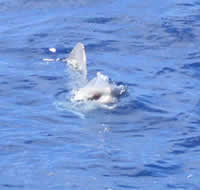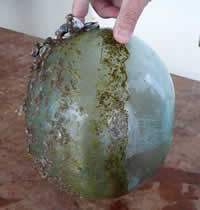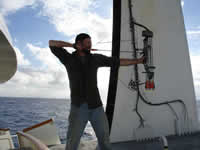


|
The Project Part 3:
Also See: Part 1: Part 2:
|
September 4, 2005
Happy Birthday! Today is my son, Zachary's, 13th birthday. Happy birthday, buddy. We put another array of carboys out this morning at 0600, which meant the water collection started at 0200. These scientists have amazing stamina to keep up with the level of activity every morning. This array will sit out there for 24 hours, like the other, and come in early tomorrow morning. It's a way to double check the data collected from the previous array. Today they are measuring temperature and gases in the water, as well as the normal stuff. Barbara has found a lot of the little coccolithophores, and I have been able to see them in the microscope. All I can say is way cool! It looks to be a beautiful day again. The sun is already shining; there are very few clouds and little wind. A Mola-Mola decided to come say hello to us today. It is the largest ocean sunfish which can get a maximum of 11 feet and around 1000 pounds. The one who came up to the ship today was huge, but probably only half of the max. They like to come up to the surface and lay on their sides sunning themselves. They have no predators, and their scales are like sandpaper. This one was curious about the boat, and ate a few small jellyfish that were around. Later on in the afternoon we recovered a glass float, which is not common. It appears to have been made from a bottle through a heating process. There is no telling how old it is. Glass floats can be 50 or more years old. They float until they collect enough sea critters, then they sink to the bottom. The critters get off their taxi, and the float rises to the surface again. Only one other crew member left to talk to, and his job is unique to science vessels. He's our Marine Technician, Daryl. He is the liaison between the scientists and the crew. His main job is to keep all the science equipment running. He works on the CTD when it has problems. He maintains the programs and important pieces of technology that the scientists would not be able to work without. He's the go to guy. He actually studied biology in school, but ended up in this field. He feels has has learned a lot through on the job experience. There are Marine Tech. programs you could go through if you were interested in a career like this. Daryl enjoys his time off by playing cribbage and practicing his target shooting with his bow. Math Questions: Have you ever wondered how many people would have to be in a group before two of them shared a birthday? As a challenge, and in honor of my son's birthday, I'd like you to go to this web address: If a green sea turtle travels across the Atlantic Ocean at 1 mile per hour, how long will it take the turtle to cross from Lisbon, Portugal to New York, New York? This problem will take an atlas, or an internet search to determine the miles between Lisbon and New York. Ocean Trivia: Have you ever wondered how they come up with maps of the ocean floor. It used to be quite a tedious task which involved dropping a weighted line to the ocean floor, and then measuring the line by arm lengths, fathoms, as it was pulled back up. For the past 60 years we have used echo soundings, bouncing sound waved off the ocean floor, to get a better picture. This is much the same as the technology in your fish finder. Today, we have multibeam echo-sounders and supercomputers that process the information and add color. There is even a Laser Airborne Bathymetric System which uses laster from the air to take images of the ocean floor. We have a much better understanding of the ocean floor today than in years past.
|




